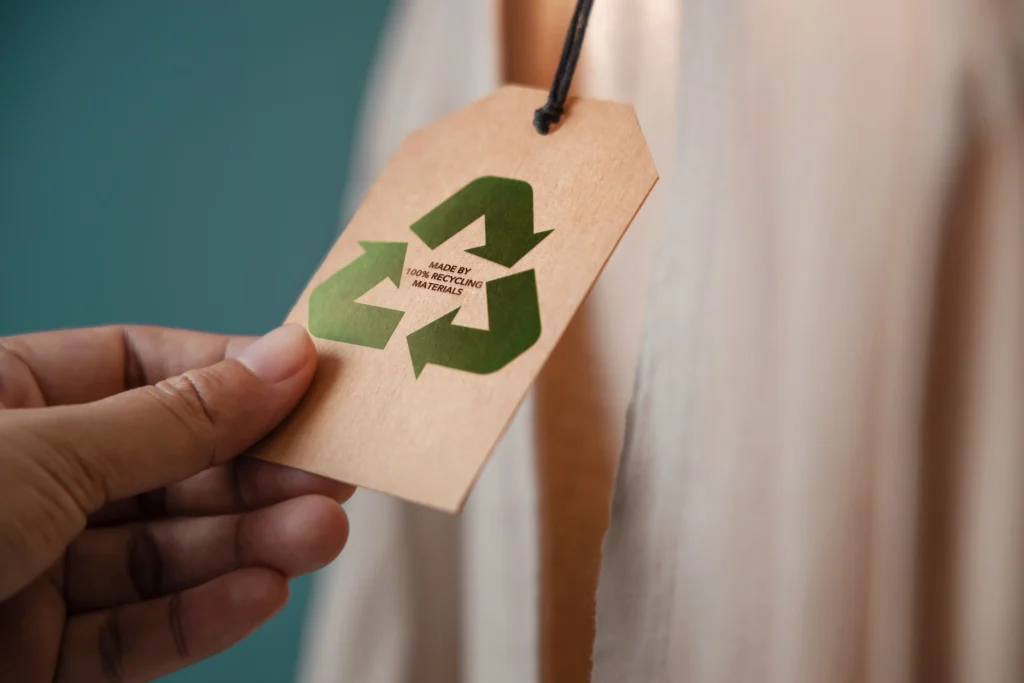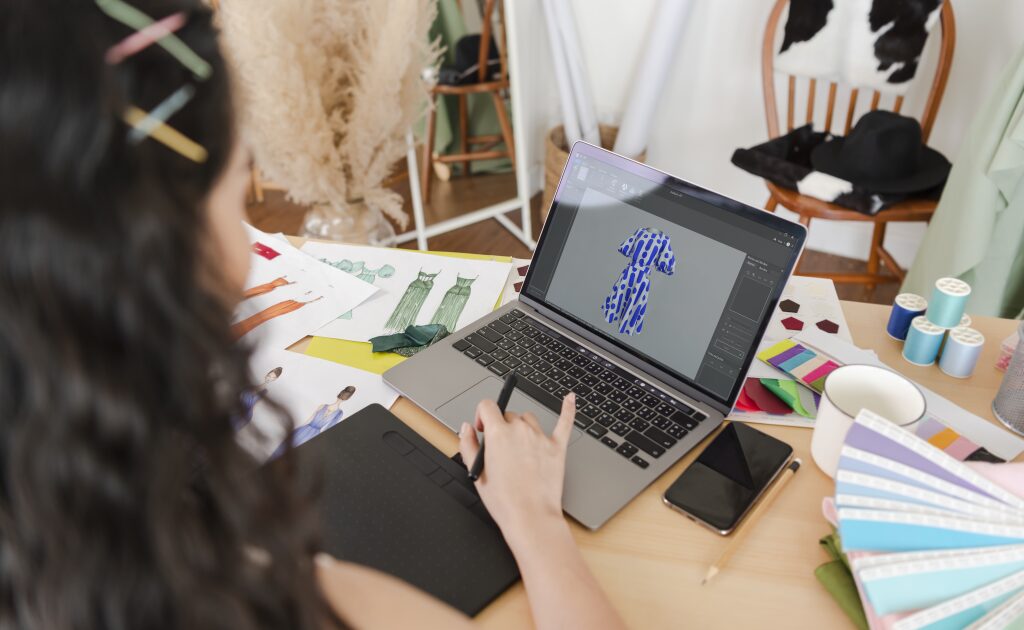Summary
- Consumers are increasingly concerned about the origins of their products and their environmental impact.
- Sustainable design has emerged as a viable alternative to reduce the textile industry’s footprint and delight customers.
- Technology can empower you to implement sustainable initiatives in your fashion company. Try Audaces360 for free and discover how!
The textile and fashion industries have been striving for several years to minimize the environmental impact of their product manufacturing processes.
Sustainability discussions often emphasize production practices alone. However, this overlooks the transformative power of sustainable design.
It can not only make your company environmentally responsible but also more efficient and cost-effective.
Discover how in this informative material we have prepared!
Sumário
What is sustainable design, and how does it impact the work of fashion designers?
Sustainable design is a comprehensive approach to product creation and usage that prioritizes minimizing resource consumption. It also extends product lifespans by incorporating renewable materials.
In today’s conscious consumer landscape, the demand for sustainable products has become paramount and sustainable design has emerged as a prominent concept, becoming a compelling selling point for brands.
Beyond fashion trends, fashion designers also need to understand the deeper desires of consumers and incorporate them into creations.
Understanding their evolving needs, interests, and desires is crucial to delivering an exceptional experience, beginning at the design and development stage of a product.
The growing environmental awareness of consumers is an important factor to consider, prompting a shift towards sustainable practices across various sectors.
The textile and fashion industries can be considered at the forefront of this movement.
Learn more: Find out how fast fashion and sustainability can coexist in the apparel industry
How to incorporate sustainable design into your creations?
When designing products, go beyond aesthetics and delve into the realm of sustainable practices. This entails carefully considering the product’s viability, taking into account environmental factors.
For example, one approach to sustainable design is to make informed material choices. Whenever possible, choose fabrics made from natural fibers and trims that can be recycled.
Another aspect involves minimizing resource usage during the creation and development phases. This includes optimizing pattern making and sample production to reduce material waste.
Traditionally, these processes involve creating numerous paper patterns and fabric garment samples.
But technology can play a pivotal role, offering tools that can significantly reduce resource consumption and streamline the workflow.
Advanced digital solutions enable the creation of complete 3D garment designs, allowing for virtual collection approvals without the need for physical samples.
For it to be truly effective, it is essential that the software accurately simulates the final garment, including its colors, textures, and drapes.
This ensures confident design decisions can be made without requiring physical samples, ultimately delivering a product that aligns perfectly with consumer values.
Learn more: Why consider sustainable consumption and production for your company?
4 sustainable design features that delight customers
Let’s delve deeper into specific sustainable design practices that can elevate your creations:
Easy recycling

The fashion industry can generate a significant amount of textile waste during cutting and production processes.
Easy-to-recycle materials minimize this waste by allowing offcuts to be collected and reintroduced into the production cycle.
The demand for these fabrics drives innovation in textile development. It encourages research into new materials made from recycled content or those that are inherently easier to recycle.
This constant innovation expands the options for sustainable fashion designers and ultimately benefits the environment.
Recycled polyester made from plastic bottles is a common example of an easy-to-recycle material. Brands are also exploring innovative materials like organic cotton blends and recycled wool.
When garments made from easily recyclable materials reach the end of their usable life, they can be readily disassembled and recycled into new products, promoting a circular clothing economy where garments have a second life.
Learn more: Embrace textile recycling practices for your fashion business
Use of biological materials
Traditional fashion relies heavily on synthetic fabrics like polyester, derived from fossil fuels.
Biological materials like organic cotton, hemp, and bamboo offer a natural alternative with a lower environmental footprint.
Their production typically requires less water, energy, and harmful chemicals compared to synthetics.
Certain biological materials, like mushroom leather and some microbial fabrics, are biodegradable and compostable.
It means they can decompose naturally, minimizing waste accumulation in landfills. This characteristic is especially important considering the vast amount of clothing discarded annually.
Learn more: How to master sustainable creation and production in the eco fashion era
Increased durability
Biological and easy-to-recycle materials are often more durable and easier to maintain, which can extend the lifespan of clothing.
They are generally more resistant than synthetic fabrics, which can pill, tear, or lose shape easily.
Many biological materials are naturally breathable and comfortable to wear. Organic cotton, for example, allows the skin to breathe better than synthetic fabrics, which can trap heat and moisture.
This translates to a more comfortable wearing experience and potentially reduces the need for frequent washing, ultimately increasing the durability of clothes.
Learn more: All you need to know about sustainable fashion jobs and Industry 5.0
Innovative design
Get creative in maximizing the use of materials when designing your collections!
You can minimize waste by allowing offcuts to be collected and reintroduced into the production cycle. For example, it can be used as a unique embellishment on a design.
The exploration of biological materials also opens doors for innovative and unique design elements.
Materials like pineapple leather or algae-based fabrics can be used to create new textures, finishes, and aesthetics.
Another approach is exploring versatile clothing designs that can be worn in various ways and adapted to different seasons, encouraging consumers to invest more in garments that will last longer.
Learn more: Learn what ESG score is and how to apply it to your clothing company
Examples of companies embracing sustainable design to inspire you
We selected some examples of companies pushing the boundaries of sustainable design. By learning from their approaches, we can all contribute to a more environmentally conscious future.
Stella McCartney

Unlike many brands that have adopted sustainability practices later, Stella McCartney has had a core commitment to ethical and eco-conscious design since its inception in 2001.
It is the world’s first major fashion house to completely eliminate leather, fur, skins, and feathers from its collections.
The brand continuously seeks out and utilizes innovative, eco-friendly resources. They use materials like organic cotton, recycled cashmere, and Mylo (a bio-fabricated leather alternative made from mushroom roots).
They continuously prove that sustainability doesn’t have to compromise on style or quality by offering luxurious and high-fashion items, demonstrating that sustainable design can be both stylish and impactful.
E.L.V Denim
Their core business model revolves around upcycling denim, a major example of how sustainable design can explore all kinds of materials.
E.L.V Denim sources discarded jeans and other denim items, giving them a new lease on life by transforming them into unique and stylish garments like skirts, jackets, and jumpsuits.
This approach significantly reduces the environmental impact associated with producing new denim from scratch.
Ninety Percent
Ninety percent stand for a unique profit model: the brand shares part of its profits. 80% goes to charitable causes, and 10% is distributed amongst the people who make their collections.
This revolutionary approach is particularly impactful within the luxury fashion industry, where profit margins are often high, but worker compensation can be low.
They strive for maximum supply chain transparency, monitoring working conditions and ensuring responsible practices that they actively communicate to consumers through various channels.
The company also offers vegan-friendly clothing and prioritizes quality, well-made garments designed for longevity.
House of Marici
House of Marici is the world’s first luxury plant-based handbag brand. They utilize Pinatex, a sustainable and innovative leather alternative made from pineapple leaf fibers.
This reduces reliance on animal leather and minimizes waste generated by the pineapple industry.
They aim to minimize fabric waste during production by utilizing leftover materials to create smaller accessories like cardholders, promoting resourcefulness and reducing textile waste.
The brand defends that well-made accessories are likely to last longer, reducing the need for frequent replacements and minimizing overall environmental impact.
They also share through their communication channels their ethics, material choices, and production processes, focused on promoting the preservation of heritage craft.
This translates to a strong selling point and emphasizes their commitment to sustainability, allowing consumers to make informed choices.
Unleash creativity in your sustainable designs with Audaces solutions
Launch your sustainable design collections with the help of industry experts!
Audaces is a world reference in fashion technology and can propel your company towards achieving its sustainability goals.
Audaces360 is a comprehensive solution that integrates advanced technologies to optimize production processes in the textile industry, suitable for companies of all sizes and types.
Our tools leverage cutting-edge technology to address real-world challenges faced by fashion businesses on a daily basis.
Here are some tools from our comprehensive suite that will assist you:
Audaces Fashion Studio

Audaces Fashion Studio empowers designers to create in a revolutionary 3D environment.
Simulate fabrics, patterns, colors, textures, and drapes with unparalleled realism, all without the need for physical garment samples.
This innovative solution allows you to create directly on a 3D mannequin, using various tools and possibilities, eliminating reliance on traditional paper drawings.
Fashion companies can experience a significant boost in agility and delivery quality with Audaces Fashion Studio.
It allows for digitally approving your entire collection seamlessly, fostering clear communication between the Style and Design departments.
Audaces Idea
Audaces Idea enables you to create precise technical drawings, ensuring exceptional detail and information accuracy.
Its automated features empower seamless collaboration between teams. Audaces Idea generates preliminary cost estimates and technical sheets automatically, keeping everyone on the same page.
It helps to reduce development time and ensures your collections launch on schedule.
Easily apply and edit prints with intuitive and user-friendly tools, so you can focus entirely on your creative vision.
By automating technical tasks, this solution frees up your time for more design exploration and project development.
Audaces Sofia
Audaces Sofia is our innovative fashion Artificial Intelligence, designed to help you enhance your creations with an unlimited source of inspiration.
It can be a great ally, fueling your creativity and transforming concepts into stunning realities in a matter of minutes.
Audaces Sofia integrates with Audaces Fashion Studio and Audaces Idea, providing you with the complete solution to create effortlessly.
Focus on your vision while Audaces Sofia enhances your workflow, allowing you to explore countless possibilities and bring your ideas to life faster than ever before.
Download our free book and discover how to design the fashion of the future with efficient and sustainable production!
FAQ
Sustainable design is a comprehensive approach to product creation and usage that prioritizes minimizing resource consumption.
When designing products, go beyond aesthetics and delve into the realm of sustainable practices. This entails carefully considering the product’s viability, taking into account environmental factors.
Easy recycling, use of biological materials, increased durability, and innovative designs.










